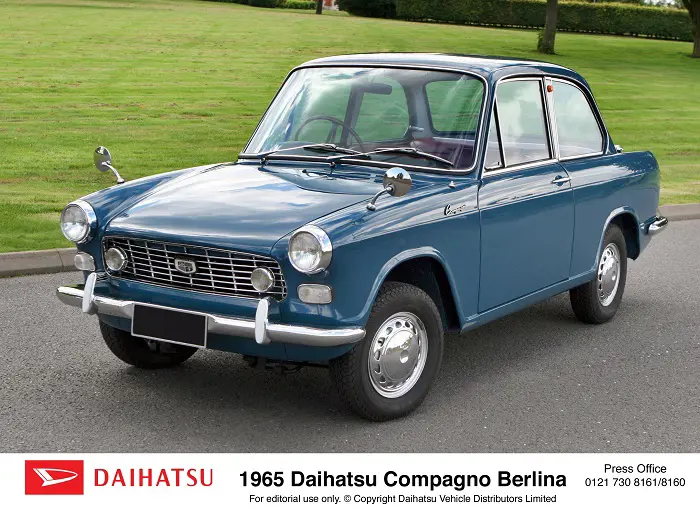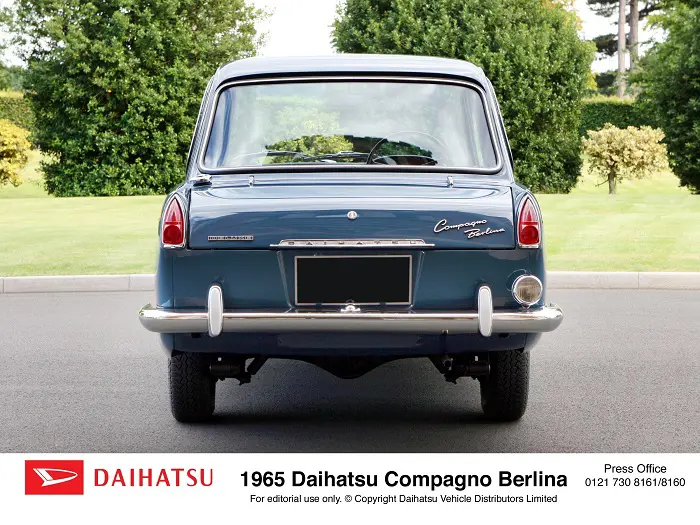THE DAIHATSU COMPAGNO – THE FIRST JAPANESE CAR IN BRITAIN
14 November 2024
Sixty years ago, the fact that HM Customs and Excise registered an innocuous-looking two-door saloon was of little interest to the average British driver. 1964 was the year of the Ford Mustang, the Sunbeam Tiger and the 4.2-litre Jaguars E-Type and Mk. X. The Austin 1800 would become the UK’s second COTY, and the new Vauxhall Victor FC appealed to those motorists with mid-Atlantic aspirations.

Meanwhile, the Reliant Scimitar appeared ideal for the Goodwood set, and the Humber Imperial and Vanden Plas Princess 4-Litre R embodied pomp and circumstance. Yet that small blue saloon proved to be one of the most important cars in the history of British motoring as this Daihatsu Compagno is the first Japanese car officially exported to the UK. It remains in the care of International Motors, which imported Daihatsus until 2011.
Daihatsu’s origins date from 1907, and they launched the Compagno in 1963. Power was from a 797cc engine, with a steering column gear lever operating the four-speed all-synchromesh transmission. The Vignale-styled coachwork (mounted on a separate chassis) denoted the company’s aspirations in export markets, as Japanese cars were already making inroads into European and Australian markets.
Dufay of Birmingham, then better known as a film stock specialist, were Daihatsu’s concessionaires and sales officially commenced in May 1965. On the 1st of June, The Birmingham Daily Post reported: “The first shipment arrived in London yesterday; another is expected on Friday, and 40-50 cars will be brought into Britain to begin with”. In addition, “around 250 dealers had ‘applied for distribution facilities”.

The Compagno appealed to families looking to graduate from their ‘Kei’ economy cars in Japan. However, import duties inflated its price to £799 when a Triumph Herald 1200 was £592. On the other hand, the Compagno featured a clock, a cigarette lighter, whitewall tyres, reclining front seats, fog and reversing lamps and whitewall tyres.
The owner also benefited from a heater with a three-speed fan, ‘trapdoor’ fresh air vents mounted beneath the fascia, electric windscreen washers, “anti-glare” glass, and even a radio with a “semi-power” antenna. The Guardian regarded its specification as “an object lesson to every other car manufacturer”.
The Daily Telegraph found the engine “smooth and free-revving and gives a comparatively lively performance with the help of a four-speed all-synchromesh gearbox”. Motor thought the blue Compagno “a dainty eyecatcher if you want to be different”. Autocar was less flattering, stating, “In the design of the suspension, engine, transmission and brakes, it follows very closely much that was popular and conventional on British cars some eight or 10 years ago”.
A further problem was the advertising. Despite such claims as “Daihatsu created the BERLINA for those who dream of sports car beauty and excitement, yet must look for family comfort and safety”, the promotions often seemed half-hearted. There were no major magazine campaigns, and there was no elaborate sales network. Dufay initially planned to market the Compagno via its London showrooms, and an advertisement from October 1965 stated, “A few vacancies for dealers and distributors still available”. This was not very reassuring to potential buyers.
In fact, Dufay was hopelessly out of its depth. In 1967, Autocar reported that “a dealer network was never established” and “no more than a handful of Daihatsu were imported last year”. Steve Eardley of International Motors told Classic and Sports Car:
Dufay only had eight vehicles to begin with and couldn’t pay the manufacturer for them until they were sold. Daihatsu in Osaka thought its distributor would honour the debt, but having sold the cars Dufay went into liquidation without paying for them.
Production ended in 1970 after around 120,000 units, and the marque did not re-appear in the British car market until 1979. Around 13 years later, Peter Kinnaird, the MD of Daihatsu UK, discovered the blue Compagno in the corner of a workshop and decided to return it to the road. I first encountered this fine car in 2005 and, after a short trip, was immediately sold on its virtues. Everything about the Compagno fascinated me, including the steering column gear change and the plastic “woodgrain” fascia trim.
Today, my impression of the Compagno is despite its high price, and the challenges of selling a Japanese car less than two decades after VJ Day, it had genuine potential in the UK. A separate chassis may have been archaic for 1965, but such engineering did not harm Triumph Herald sales. The Compagno was also expensive and slow, with a 66-mph top speed, but an ambitious concessionaire could have plausibly marketed it as an upmarket town car.
And, properly marketed, the Compagno might have established goodwill for the marque in this country when car-buying habits were starting to change. 1965 was also the year Toyota exhibited its wares at the London Motor Show. By 1967, Japan was the world’s second-largest producer of motor vehicles after the USA, with Honda and Mazda established in this country. Meanwhile, Toyota GB already had a network of around 150 dealerships. Daihatsu could have enjoyed some of this success, for the Compagno is a delightful vehicle.
Ironically, that Autocar report of 1965 encapsulated the blue Daihatsu’s appeal. They said it impressed “for quality of workmanship, and there are many who understandably attach great importance to this and prefer a car that is well made, even if outdated and of inferior design, to one which is technically superior but badly constructed”.
Leaving aside “of inferior design”, this formula resulted in Datsun becoming the UK’s top imported car marque by the 1970s. And while the Compagno was destined never to be a familiar sight in this country, this 1964-registered example heralded a minor social revolution in how we bought cars.
With thanks to https://www.internationalmotors.co.uk for their time and permission to use the images in this blog.
